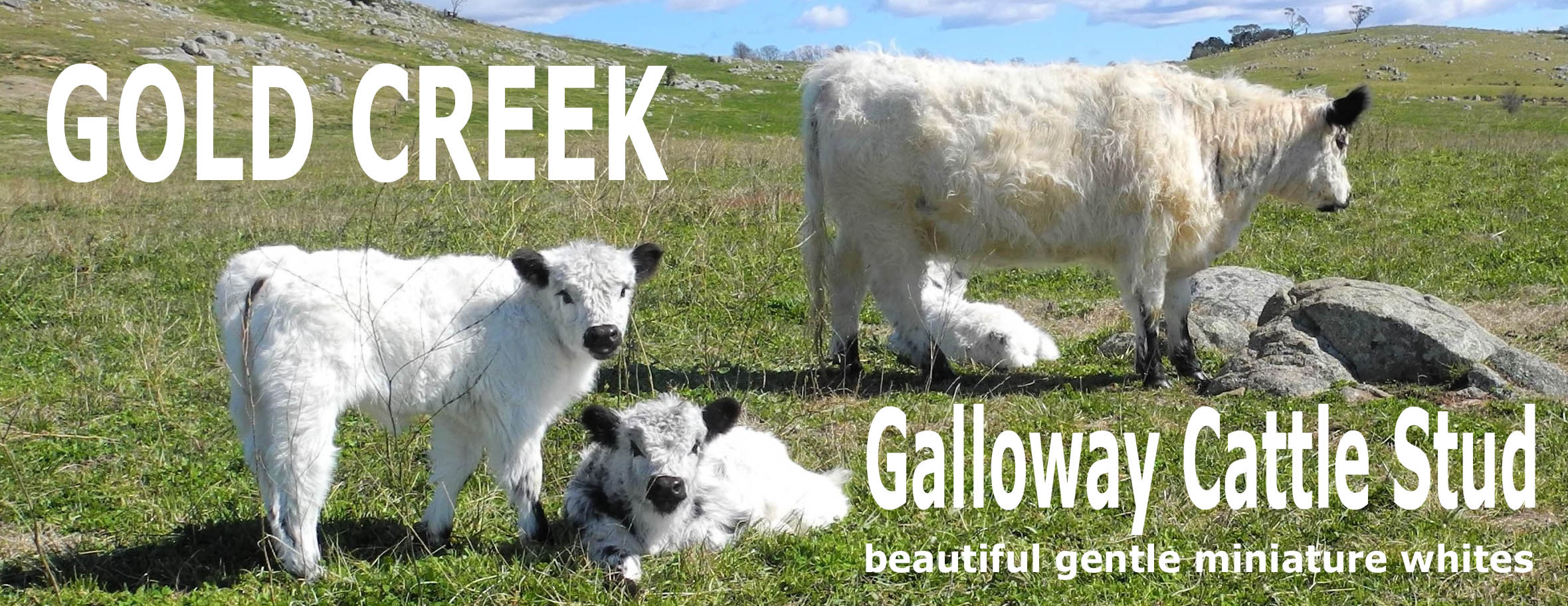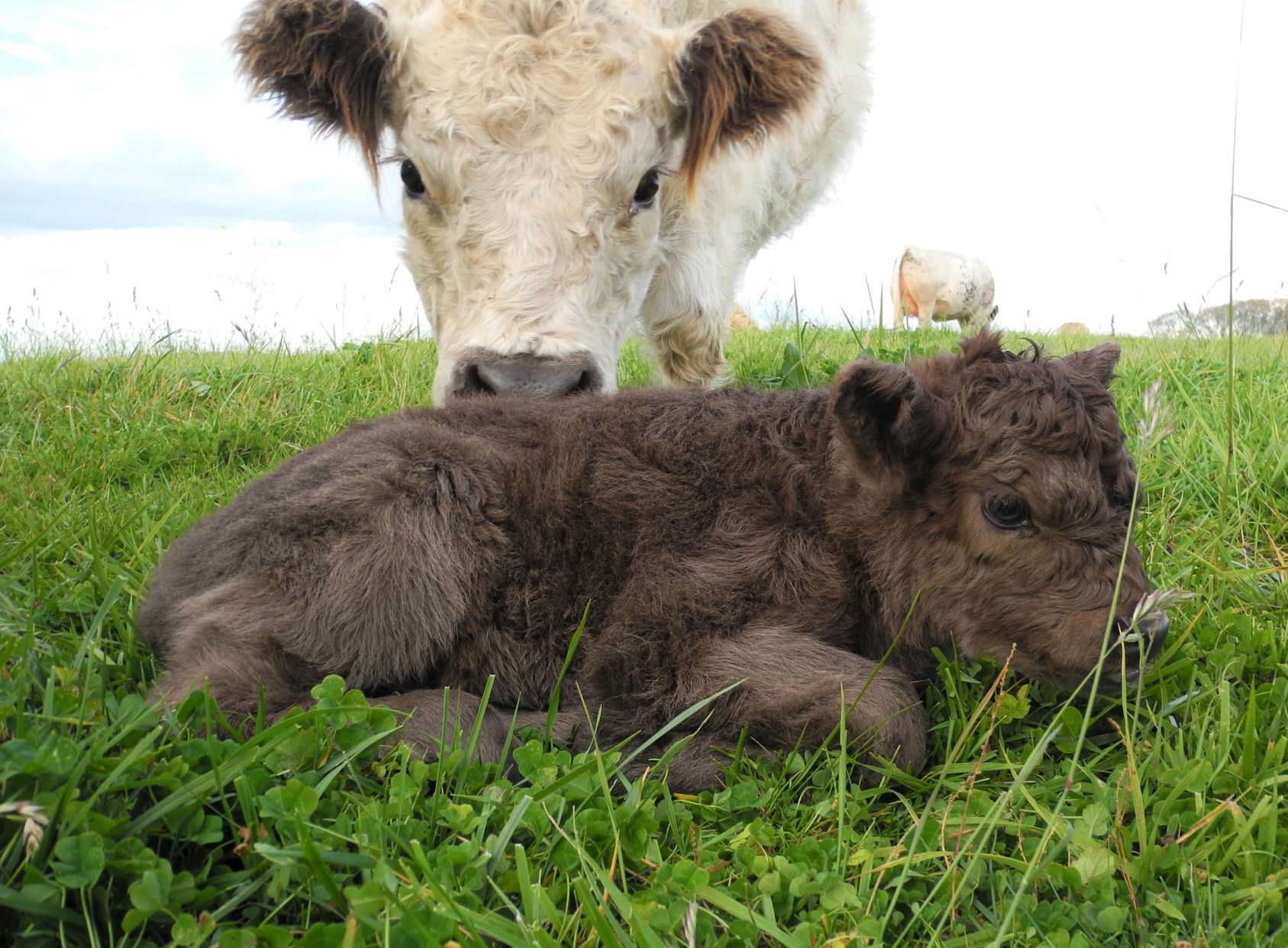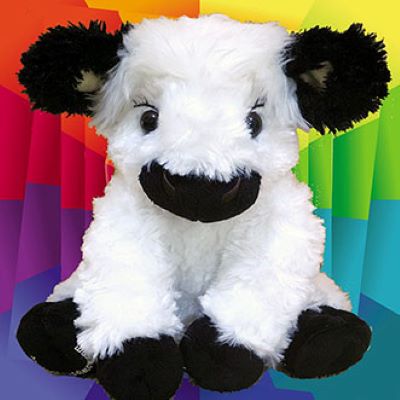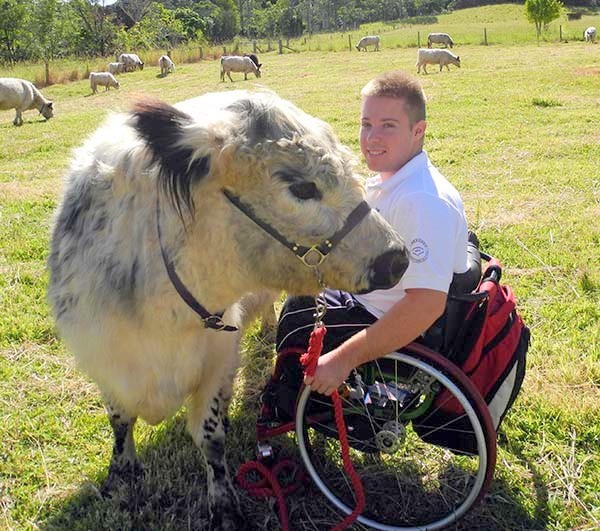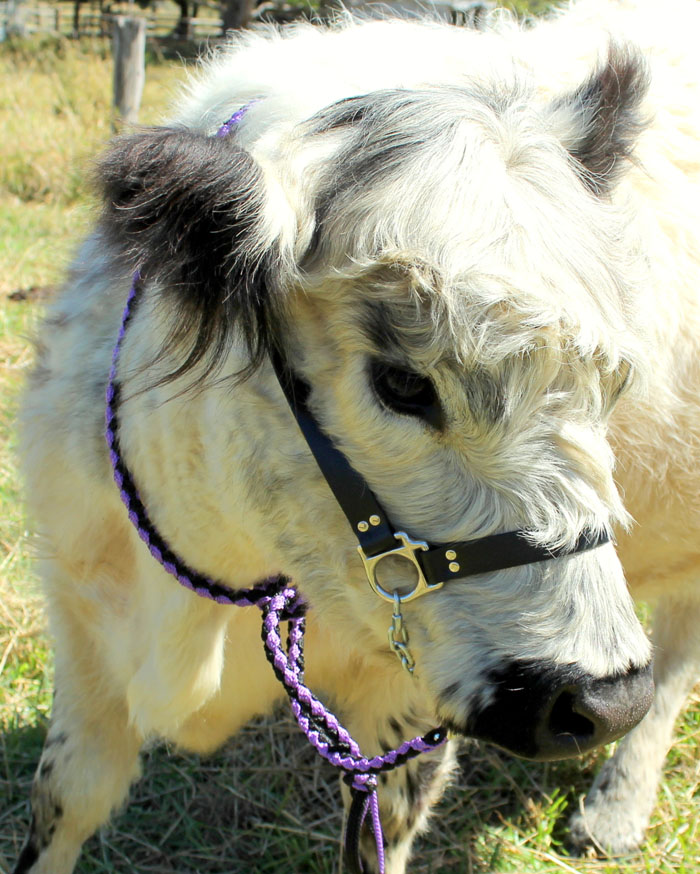Galloway Types
White Galloways with Red Points
Traditional White Galloway cattle with red points are the least common of the White Galloways. There could be a variety of reasons for this combination being less common than the White Galloways with black or dun points - but is certainly not appearances. White Galloway cattle with red points are a very attractive animal indeed. At Gold Creek, we are currently reconsidering whether to breed a couple more of these beautiful cattle.
The points on White Galloway cattle are the muzzle, the eyes, ears and hooves. The red on the hooves usually goes partway up the legs.e The cows often have reddish teats and reddish skin under their tails. Many of these cattle have reddish markings on their actual skin that do not appear on their white coats. It is believed that the reddish skin helps protect them from skin cancer in Australia.
Red Points
There is a limited number of White Galloway cattle with red points in Australia. This colour can be achieved by breeding with two White Galloways with red points - a White cow and a White bull (or just one or the other having the red points).
White Galloway cattle with red points can also be bred by using a red Galloway cow and a White Galloway bull with points of another colour. Or some breeders use a red Galloway bull with a White Galloway cow with points of another colour.
The Galloways have a double coat of hair, consisting of a long, shaggy overcoat and a soft, thick undercoat. Providing excellent insulation in cold, bleak weather and reducing the amount of feed intake required to maintain body weight. On White Galloways with the red points, this white coat looks great and serves these miniature cattle well in most Australian climates.
White Galloway Cattle - Dun Points
Traditional White Galloway cattle with dun points are popular with a number of the White Galloway breeders. They are not as common as the White Galloways with black points and there could be a variety of reasons for this combination being less common.
The points on White Galloway cattle are the muzzle, the eyes, ears and hooves. The dun on the hooves usually goes partway up the legs. The cows often have brownish teats and brownish skin under their tails. Many of these cattle have brownish markings on their actual skin that do not appear on their white coats. It is believed that brownish skin helps protect them from skin cancer in Australia.
A white with dun points Galloway cow named Brae is checking out a solid dun calf, Tully. April 2020.
Dun Points
There are relatively few White Galloways with dun points in Australia. This colour combination can be achieved by breeding with two White Galloways with dun points - a White cow and a white bull. They can also be bred by using a dun Miniature Galloway cow and a White Galloway bull. Or some breeders use a dun Galloway bull with a White Galloway cow with points of a colour other than dun.
They have a double coat of hair, consisting of a long, shaggy overcoat and a soft, thick undercoat. Providing excellent insulation in cold, bleak weather and reducing the amount of feed intake required to maintain body weight, this white coat with the dun point looks great and serves the Galloway well in most Australian climates.
Traditional White Galloway cattle with black points are the most common of the White Galloways. There could be a variety of reasons for this combination being more common - it is certainly a very striking look.
The points on White Galloway cattle are the muzzle, the eyes, ears and hooves. The black on the hooves usually goes part way up the legs. The cows often have black teats and black skin under their tails. Many of these cattle have black markings on their actual skin that do not appear on their white coats. It is believed that the black skin helps protect them from skin cancer in Australia.
They have a double coat of hair, consisting of a long, shaggy overcoat and a soft, thick undercoat. Providing excellent insulation in cold, bleak weather and reducing the amount of feed intake required to maintain body weight this white coat looks great and serves the Galloway well in most Australian climates.
Breeding White Galloways with Black Points
There are more White Galloway cattle with black points than any other colour combination within the White Galloway herd. This colour can be achieved by breeding with two White Galloways with black points - a White cow and a White bull.. They can also be bred by using a black Galloway cow and a White Galloway bull. Or some breeders use a black Galloway bull with a White Galloway cow.
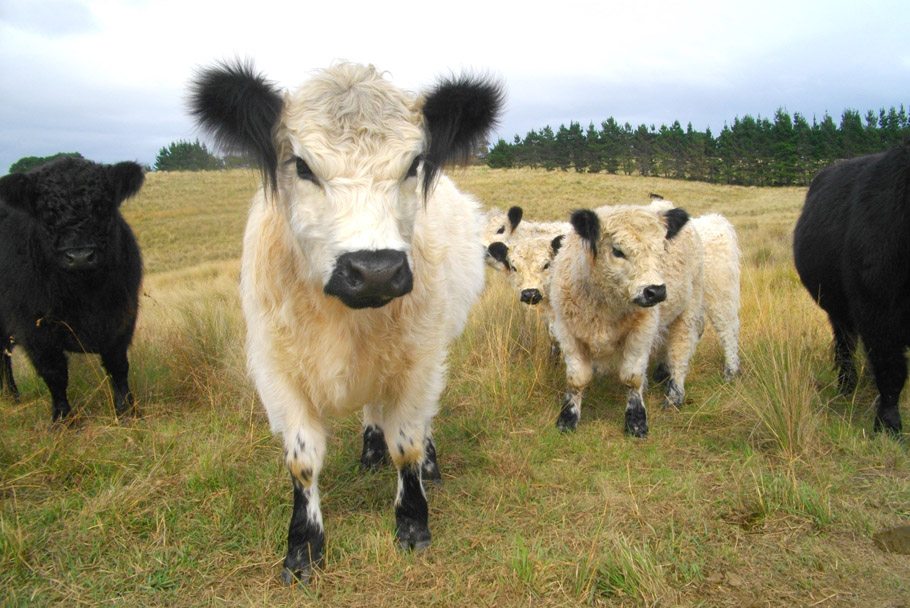
Perfectly marked small White Galloway heifer with black points (ears, eyes, muzzle and hooves).
Miniature Galloway Cattle - Black Coats
Miniature Galloway cattle with black coats are the most common of the Miniature Galloways.
They have a double coat of hair, consisting of a long, shaggy overcoat and a soft, thick undercoat. Providing excellent insulation in cold, bleak weather and reducing the amount of feed intake required to maintain body weight the black coat looks great and serves the Miniature Galloway well in most Australian climates.
Breeding Miniature Galloways with Black Coats
There are more Miniature Galloway cattle with black coats than there are dun or red coats. The black can be achieved by breeding with two Miniature Galloways with black coats. They can also be bred when a breeder is by using a black Miniature Galloway cow and a Miniature Galloway bull of another colour. It can also occur when breeders use a black Galloway bull with a Miniature Galloway cow of another colour.
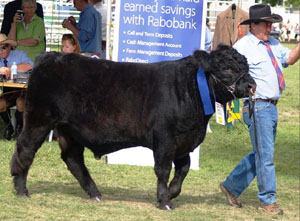
Gunadoo Yea George: Black Full Blood Miniature Galloway Bull bull in the show ring.
Miniature Galloways with Black Coats
Miniature Galloway cattle with black coats have all the good traits of the larger Galloway cattle with all the advantages of cattle that come in a 'smaller package'.
Galloways are one of the oldest naturally polled breeds, and therefore the characteristics that the Galloway breed can bring to your herd have been stabilised over many generations of breeding.
These characteristics include:
1. Fertility — Galloway bulls are very fertile at an early age. (Reports from Tasmania of one beef producer who turn out a 3 year old Hereford bull and an 18 month old Belted Galloway with 26 heifers. The Hereford was much bigger and the producer doubted if the Belted Galloway bull would have the opportunity to breed any of the heifers. Nine months later his opinion of the Belted Galloway bull changed. The first 24 calves born were by the Belted Galloway bull).
If you want your cows in calf – the Galloway is the bull for the job.
2. Ease of Calving — Research completed by the Clay Animal Research Centre, in Nebraska tested 11 breeds for their ability to give birth and rear their calf. The Galloways recorded the highest weaning percentage (95.5%) and the highest calf survival percentage (95.2%). The Galloways also had an outstandingly low incidence of calving difficulty (0.8%). The Galloway calf is very vigorous at birth which helps it to survive those crucial first few days of life.
There is no profit in a dead calf – make sure of your calving ease by using a Galloway bull.
3. Maternal Traits & Longevity — Galloway females are very protective of the calves and will produce a live viable calf well into their teens. They produce a high quality milk and will look after their calves in all conditions.
4. Non-Selective Grazers — Research in Europe has shown that Galloways will graze over the whole paddock which allows the grasses to be able to compete with the weeds. They have the ability to forage under sparse conditions and as a result can be finished on pasture with only pasture hay or silage as a supplement.
5. High Quality & High Yielding Carcasses — The typical Galloways carcass is well muscled, long and with optimum fat cover. Rarely does a Galloway cross have too much fat cover. Galloway crosses have been shown in feedlot trials to have the same marbling and growth rate as Angus crosses, but better yield and less back fat (external fat). Carcass competitions have shown that Galloway carcasses typically are high yielding, with figures often around 73%.
6. Produce High Quality Healthy Beef — In Canada, USA and Switzerland research has shown that beef which is extensively produced can be of great benefit in a healthy diet. Galloway beef raised under extensive conditions is rich in linoleic acid. The human body does not produce linoleic acid and therefore it must be included n our diet. Linoleic acid reduces the dangerous type of cholesterol (LDL), prevents thrombosis and therefore protects coronary vessels. Research by Dr Butson, Canada also has shown that Galloway beef has good levels of the essential fatty acids Omega 6 (linoleic acid) and Omega 3 (linolenic acid).
7. The Breed to Cross Breed — Galloway females are highly suited to joining with other breeds, with their easy-calving, good mothering and ability to do well in any conditions. A long-living, excellent F1 mother is the result of crossing a Galloway with other breeds – the genetic difference will add hybrid vigour and the crossbred female will be as robust, efficient and as mobile as her dam.
* The above traits are passed on at a very high degree to cross bred offspring.
Galloway bulls have the ability to produce an even line of calves – in colour, polledness and high quality carcasses from mixed lines of cows. The Galloway polling dominance in crossbreeding ensures 100% polled calves from horned females.
Miniature White Galloway
Miniature White Galloways are the 'new kids on the block' when it comes to Miniature Galloway cattle. The Whites come in three different colour combinations also.
There are MIniature White Galloways that are all white. Then there are MIniature White Galloway cattle that are white with coloured points. The 'points' are the muzzle, the eyes, ears and hooves of the cattle. Some Whites have splashes or speckles of colour on their sides and backs and sometimes on their faces. As many people like the splashes and speckles as those who prefer the coat to be 'clean'.
Black Points
There are Miniature White Galloways with black points. This colour can be achieved by breeding with two Miniature White Galloways with black points. They can also be bred by using either a black Galloway cow or a black Galloway bull with a White Galloway.

Dun Points
There are Miniature White Galloways with dun points. This colour can be achieved by breeding with two Miniature White Galloways with black points. They can also be bred by using either a dun Galloway cow or a dun Galloway bull with a White Galloway.

Brae with dun points and her heifer calf Bessie with black points.
Red Points
There are Miniature White Galloways with red points. This colour can be achieved by breeding with two Miniature White Galloways with red points. They can also be bred by using either a red Galloway cow or a red Galloway bull with a White Galloway.

Gleneagles Phoenix
Owners of Miniature White Galloways
Owners of the Miniature Whites say they chose their whites for different reasons. Some thought the little black ears and noses were so cute they fell in love. Others said it was because they thought the white coats might be cooler in the hotter climates experienced in northern parts of Australia. Whatever the reasons people are choosing the Miniature White Galloways, they are certainly becoming pretty popular.
